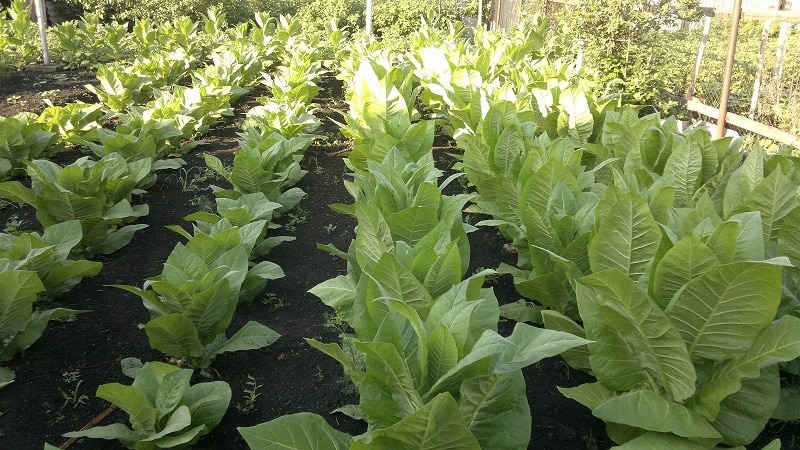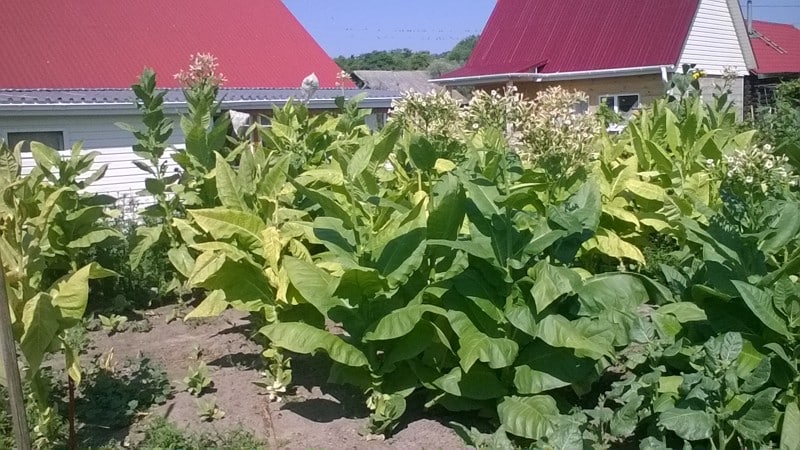The most popular variety of Virginia tobacco for growing on site and at home
Virginia tobacco is a popular variety, accounting for 70% of the total volume cultivated tobacco. It has found application in all tobacco mixtures, including hookahs. Any gardener can grow a plant if he follows the recommendations of experts.
What kind of tobacco is this?
The variety is considered sweet, as it contains 20% sugar. This indicator allows tobacco to be stored in mixtures for a long time. After a few years, its taste will only improve.
Description and characteristics
This plant is tall, reaches 2 m. The resulting raw material is capable of absorbing aromatic additives. It has a simple technological processing process, and steam is most often used for this. Tobacco that has undergone this treatment is used in all pipe blends.

Taste and aroma qualities
The Virginia variety has a unique sweetish taste with a pronounced fruity note. Cigarette smoke has a delicate and aromatic taste. Tobacco strength can be mild or medium. The nicotine content is relatively low at 1-3%, making this variety extremely in demand.
Kinds
There are several varieties of virginia, or virginia, tobacco. They differ in color and aroma. In the tobacco industry they are used as additives or in pure form.
- GoldVirginia. It is distinguished by a sweetish taste.Often used in combination with Cavendish tobacco.
- RedVirginia. It has a small amount of sugar in its composition. Its aroma is similar to the smell of baked goods. Some of the best tobacco of this variety is produced in Africa. It is produced primarily in combination with natural unsweetened tobacco blends, for example, PetersonSherlockHolmes.
- MaturedVirginia. Subject to prolonged aging. The main characteristic is a spicy taste with fruity notes.
- StovedVirginia. Tobacco leaves turn black after special roasting. This subspecies is characterized by the aroma of chocolate and the taste of dried fruits.
Advantages and disadvantages
Virginia is considered one of the best tobaccos in its category for cigar production. It is characterized by a specific aroma. The presence of a high-quality component in this composition is the key to obtaining a decent smoking mixture.
An excellent harvest is achieved even in conditions with an unstable climate. The variety is resistant to pests and diseases. The harvest is stored for a long period.
Growing regions
Virginia tobacco grows in North America, Brazil, and India. Plantations are also located on the African continent in Zimbabwe. In Russia, it is almost never grown for industrial purposes, but farmers in the southern regions do it successfully on private farms.
Growing and care

Plants of this variety are grown on the site in seedlings. There are several nuances that are worth considering.
Location on
Seeds are sown in moist soil in sufficiently spacious containers. The plantings are covered with film or glass, maintaining a temperature of + 28°C. After emergence of seedlings, the temperature is reduced to 25°C. Water the crop as needed, remove weeds and ventilate the room with seedlings daily.Fertilizing is done 2-3 times with organic and mineral fertilizers, for example, chicken manure.
Transplantation of seedlings into the ground is carried out at approximately 45 days of age, when the stem has five leaves and the root system has become stronger. By this point, the soil should warm up to +10°C; if it is colder, you will have to wait until planting.
The plants are watered before transplanting. The interval between holes is left 1 m.
At the time of foliage formation, make sure that the plant receives enough moisture. In addition, watering is carried out several days before collecting leaves. The plant needs light, then the quality of the leaf will be highest. Tobacco does not require cutting. The leaves grow together, which allows gather them at the same time.
Growing at home
Before planting, dry seeds are wrapped for a day in a cloth moistened with water mixed with tartaric acid or potassium nitrate (in a 1:1 ratio). This will increase seed germination by 20%. Afterwards, the seeds are washed, wrapped again in a cloth, placed in an enamel bowl and placed in a warm place. Occasionally moisten the material with a solution of water and tartaric acid or potassium nitrate. Sprouted seeds are mixed with 100-200 g of sand.
Tobacco is planted in the last days of February or in the first ten days of March. Take small individual containers (small boxes, cups) with holes in the bottom, fill them with soil for planting the crop (three parts humus and one part sand). After the seeds are planted, they are sprinkled with a 10 mm layer of the same substrate on top.
After sowing the seeds, water the soil through a strainer so as not to erode the top layer of soil. The container is covered with a thin film and placed in a bright place, but without direct sunlight.
The container with seeds is kept at a temperature of +23…+28ºC. The seedlings are watered daily and must be ventilated twice a day. When the leaves of the seedlings peck, the temperature is lowered to +20ºC, and watering is done twice a day. When 3-4 leaves appear, the seedlings are planted in a large container. Then fertile soil is sprinkled twice under the seedlings.
When inflorescences appear, treat the crop with an infusion prepared from garlic and onion peels. This procedure is performed three times with a break of a week. Fertilizers with nitrogen and potassium are also applied, which will protect the plant from diseases.
The leaves are collected in August. If you follow all the recommendations, the tobacco will be of the highest quality.
Processing Features

Ripe leaves are collected, strung on a cord and sent to the barn to dry. It includes two stages: languishing and fixation. For simmering they use a drying shed. The room temperature is maintained from +26°C to +30°C.
At this stage, as a result of a number of biochemical processes, the nicotine content decreases, and the proportion of aromatic compounds increases. Due to this, the characteristics of the tobacco leaf are improved.
The last stage of drying - fixation - occurs under the sun and takes twenty days.. This process allows the leaves to acquire the necessary characteristics and become suitable for processing.
Fermentation
The process involves changes in physical characteristics that occur as a consequence of biological or chemical influence. Natural fermentation of plant leaves is ensured by their long-term storage. If you use an artificial method, fermentation accelerates significantly.
Experts suggest fermenting tobacco at home following a certain algorithm. They also advise that when carrying out the procedure outside, make sure that no precipitation gets on the leaves.
First of all, dry leaves that have no traces of greenery need to be moistened on both sides with a spray bottle. They are stacked and covered with polyethylene. A day later, the midrib is removed from the leaves. Be sure to pay attention to their humidity level. This is important because it determines the quality of the process. A dry and elastic sheet is suitable for processing.
The leaves are cut into strips. The prepared tobacco is placed in glass jars. They are filled two-thirds full, which will allow you to further mix the contents by shaking. The jars are closed with lids and placed in the oven, in which the temperature is +50°C. The process lasts five days.
The contents in the jars are shaken periodically. Make sure there is no condensation on the walls of the containers. If it appears, the contents are poured out and dried again. The process is then resumed. It is easy to understand that everything is going right by the presence of the aroma of honey on the second or third day.
The prepared tobacco is poured onto a flat surface and dried. As a result, the strength, content of dangerous tars and nicotine are significantly reduced, and the tobacco taste is improved. Store tobacco in a hermetically sealed container.
Reviews

Experienced tobacco workers share their impressions of variety.
Vladimir Alexandrovich, 50 years old: «I grow Virginia myself, at home for myself. The main thing is a bright windowsill, watering and fertilizing. And a small kitchen planting will yield a good harvest. I believe that homemade cigars are safer. Virginia combines well with other varieties, but it’s not for everyone.”
Gleb, 29 years old: “I think the most difficult part is drying tobacco and the process of its fermentation. This is the most critical stage on which taste depends. The experience of a tobacco grower is not easy and requires patience. I am convinced that even the simplest shag, grown independently, will be much superior to store-bought cigarettes in terms of taste. I ferment tobacco with the taste of cherry, cognac, and vanilla. Everything works out, the main thing is desire.”
Conclusion
Virginia is the optimal, proven variety of tobacco for hand-made cigarettes. Its trademark is its sweetish taste. This variety has several subspecies, each of them contains nicotine from 1% to 3%. The variety is grown in seedlings and requires special conditions of maintenance and care.